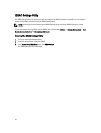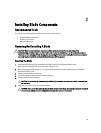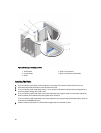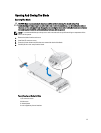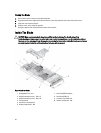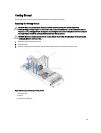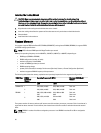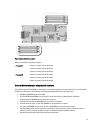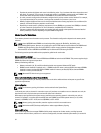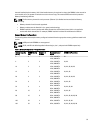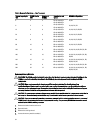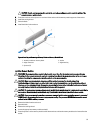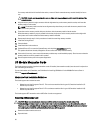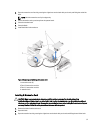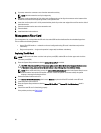
• Populate the sockets by highest rank count in the following order - first in sockets with white release levers and
then black. For example, if you want to mix quad-rank and dual-rank DIMMs, populate quad-rank DIMMs in the
sockets with white release tabs and dual-rank DIMMs in the sockets with black release tabs.
• In a dual-processor configuration, the memory configuration for each processor must be identical. For example,
if you populate socket A1 for processor 1, then populate socket B1 for processor 2, and so on.
• Memory modules of different sizes can be mixed provided that other memory population rules are followed (for
example, 2 GB and 4 GB memory modules can be mixed).
• Depending on mode-specific guidelines, populate two or three DIMMs per processor (one DIMM per channel)
at a time to maximize performance. For more information, see Mode-Specific Guidelines.
• If memory modules with different speeds are installed, they will operate at the speed of the slowest installed
memory module(s) or slower depending on system DIMM configuration.
Mode-Specific Guidelines
Three memory channels are allocated to each processor. The allowable configurations depend on the memory mode
selected.
NOTE: x4 and x8 DRAM based DIMMs can be mixed providing support for (Reliability, Availability, and
Serviceability) RAS features. However, all guidelines for specific RAS features must be followed. x4 DRAM based
DIMMs retain Single Device Data Correction (SDDC) in either memory optimized (independent channel) or
Advanced ECC modes. x8 DRAM based DIMMs require Advanced ECC mode to gain SDDC.
The following sections provide additional slot population guidelines for each mode.
Advanced ECC (Lockstep)
Advanced ECC mode extends SDDC from x4 DRAM based DIMMs to both x4 and x8 DRAMs. This protects against single
DRAM chip failures during normal operation.
Memory installation guidelines:
• Memory sockets A1, A4, B1, and B4 are disabled and do not supported Advanced ECC mode.
• DIMMs must be installed in matched pairs — DIMMs installed in memory sockets (A2, B2) must match DIMMs
installed in memory sockets (A3, B3) and DIMMs installed in memory sockets (A5, B5) must match DIMMs
installed in memory sockets (A6, B6).
NOTE: Advanced ECC with mirroring is not supported.
Memory Optimized (Independent Channel) Mode
This mode supports SDDC only for memory modules that use x4 device width and does not impose any specific slot
population requirements.
Memory Sparing
NOTE: To use memory sparing, this feature must be enabled in the System Setup.
In this mode, one rank per channel is reserved as a spare. If persistent correctable errors are detected on a rank, the
data from this rank is copied to the spare rank and the failed rank is disabled.
With memory sparing enabled, the system memory available to the operating system is reduced by one rank per
channel. For example, in a system with three 8 GB dual-rank DIMMs, the available system memory is: 1/2 (ranks/
channel) × 3 (DIMMs) × 8 GB = 12 GB, and not 3 (DIMMs) × 8 GB = 24 GB.
NOTE: Memory sparing does not offer protection against a multi-bit uncorrectable error.
NOTE: Both Advanced ECC/Lockstep and Optimizer modes support Memory Sparing.
Memory Mirroring
Memory Mirroring offers the strongest DIMM reliability mode compared to all other modes, providing improved
uncorrectable multi-bit failure protection. In a mirrored configuration, the total available system memory is one half of
32



